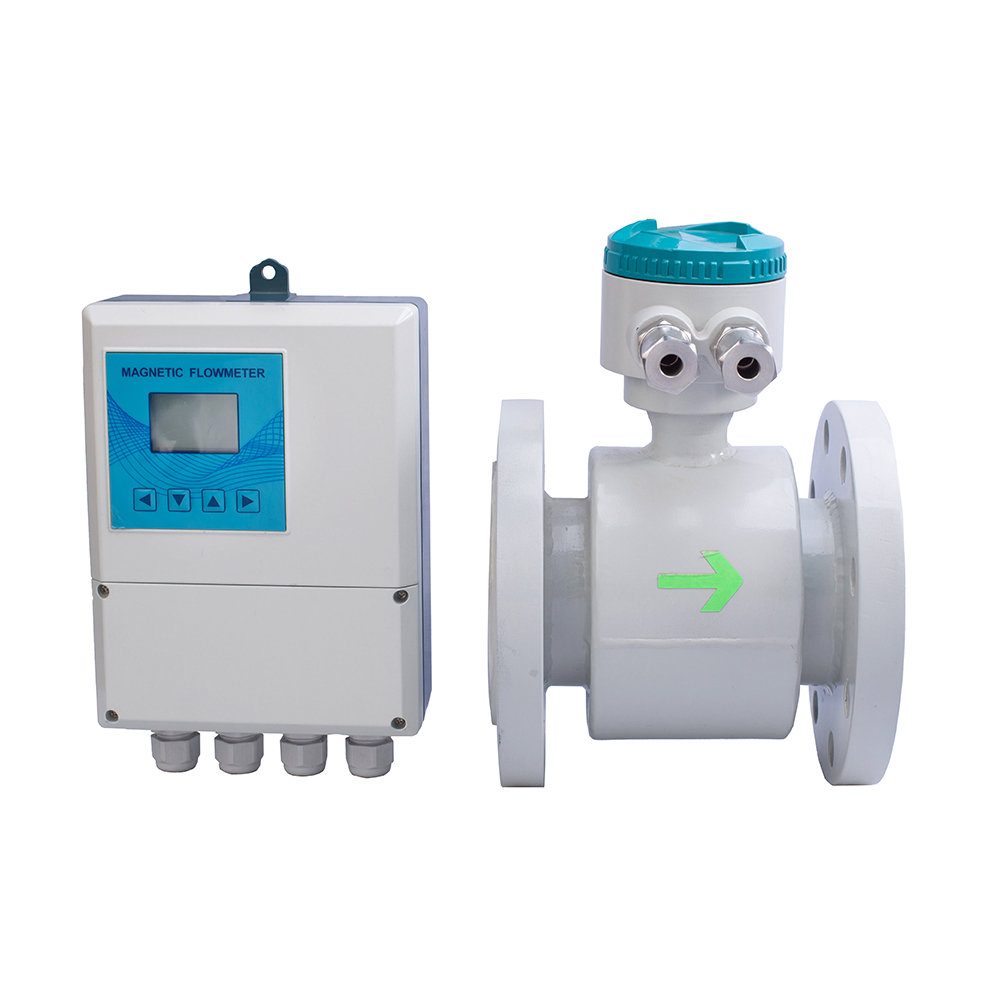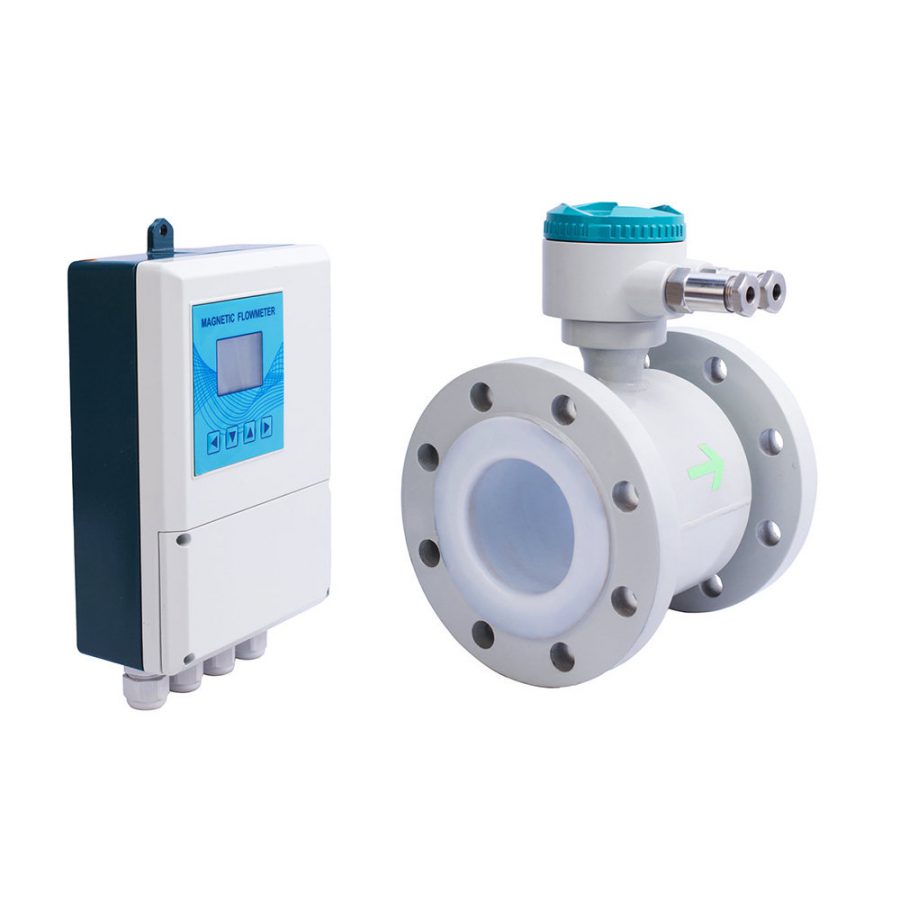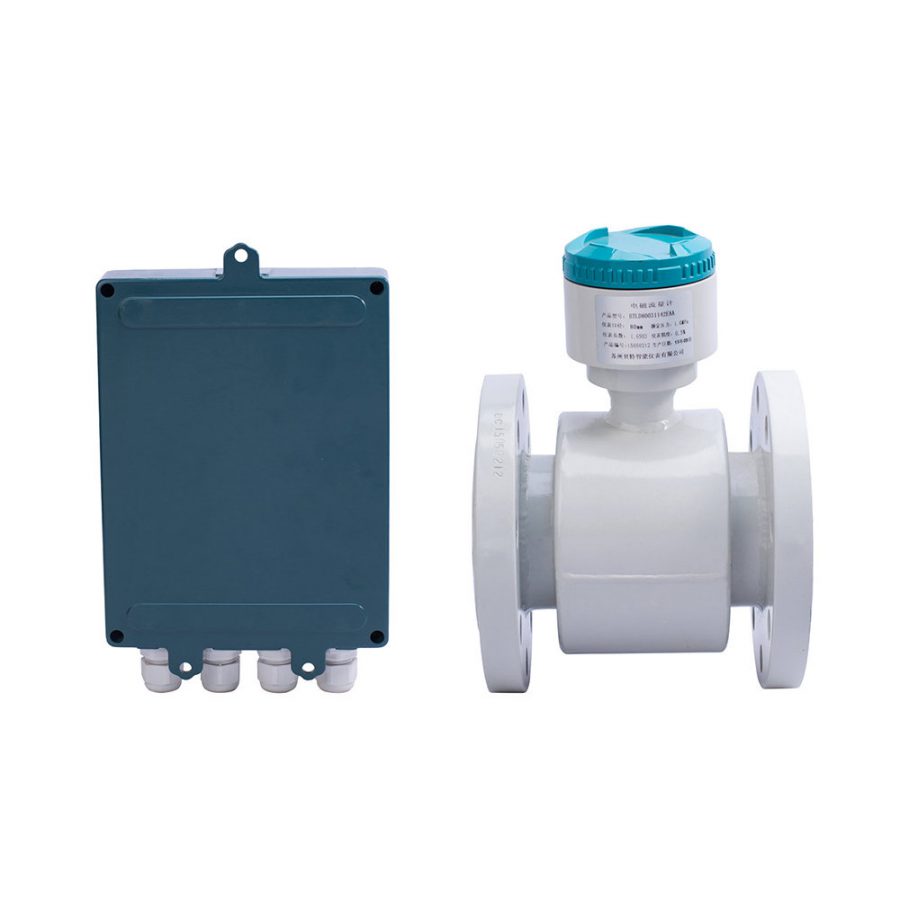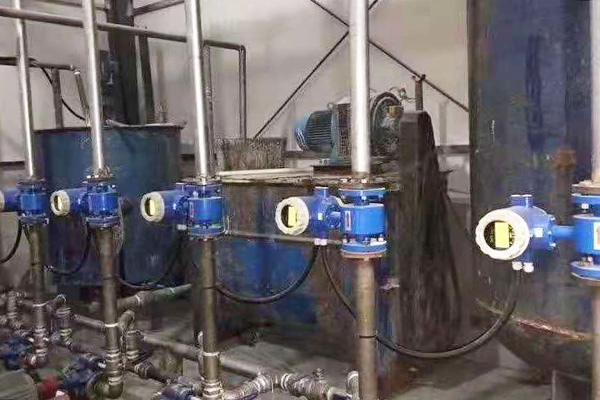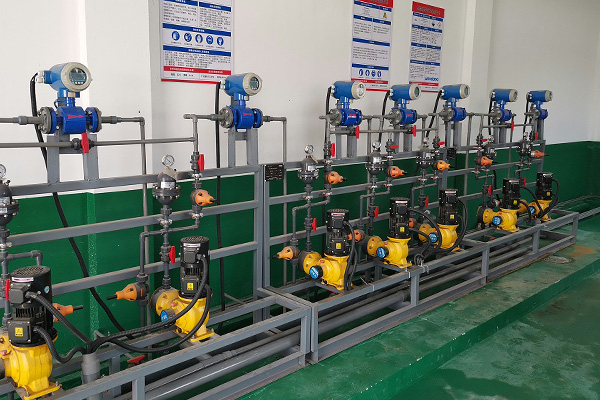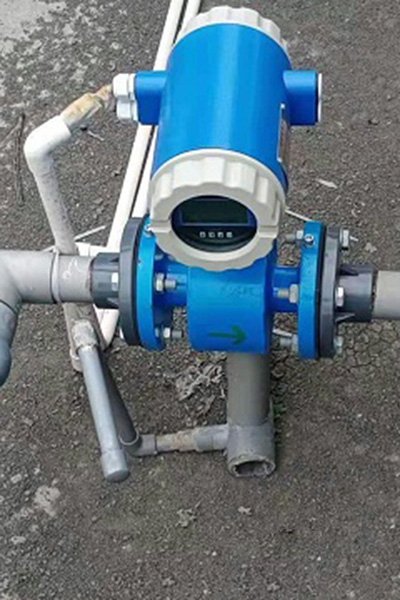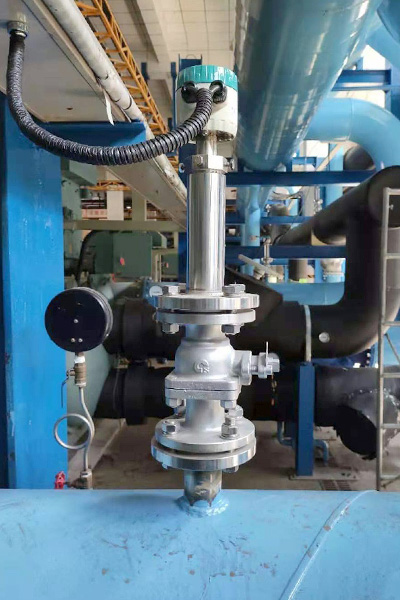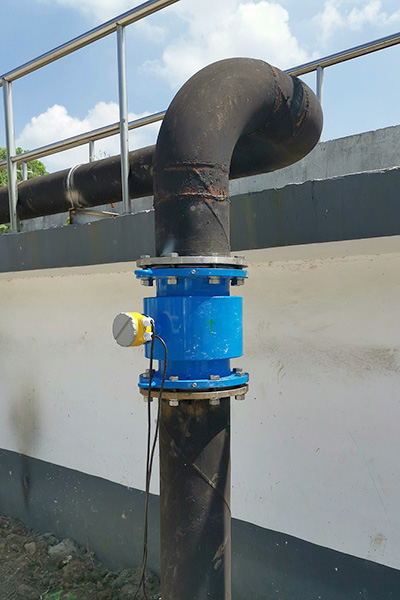Principle and structure
The measurement principle of the intelligent electromagnetic flowmeter is based on Faraday's law of electromagnetic induction. The intelligent electromagnetic flowmeter consists of a sensor and a converter. The sensor is installed on the measuring pipe. The converter can be combined with the sensor and connected together to be called an integrated electromagnetic flowmeter. The converter is installed within 30 meters or 100 meters from the sensor. The two are connected by a shielded cable and are called a separate electromagnetic flowmeter. The main components of the intelligent anti-corrosion electromagnetic flowmeter sensor are: measuring tube, electrode, excitation coil, iron core and yoke shell. The measuring tube of the flowmeter is a short non-magnetic alloy tube lined with insulating material. The two electrodes are fixed on the measuring tube through the pipe wall along the pipe diameter. The electrode head is basically flush with the inner surface of the lining. When the excitation coil is excited by a double-wave pulse, a working magnetic field with a magnetic flux density of B will be generated in the direction perpendicular to the axis of the measuring tube. At this time, if a fluid with a certain conductivity flows through the measuring tube. The measured medium flows through the pipeline and cuts the magnetic lines of force, generating an induced electromotive force E. The electromotive force E is proportional to the magnetic flux density B, the product of the inner diameter d of the measuring tube and the average flow velocity v. The electromotive force E (flow signal) is detected by the electrode and sent to the converter through the cable. After the converter amplifies the flow signal, it can display the fluid flow rate and output pulses, analog current and other signals for flow control and regulation.
Scenario application
Produktmerkmale
1. Measurement is not affected: The measurement is not affected by changes in fluid density, viscosity, temperature, pressure and conductivity.
2. No obstruction to flow components: There are no obstruction to flow components in the measuring tube, no pressure loss, and the straight pipe section requirements are low.
3. Series nominal diameter: The series nominal diameter is DN15~DN3000, and there are many options for sensor lining and electrode materials.
4. Novel excitation method: The converter adopts a novel excitation method with low power consumption, stable zero point and high accuracy. The flow range can reach 1500:1.
5. Converter: The converter can be integrated or separated with the sensor.
6. Reliable programming: The converter adopts a 16-bit high-performance microprocessor and 2x16LCD display, which is convenient for parameter setting and reliable programming.
7. Bidirectional measurement system: The flow meter is a bidirectional measurement system with three integrators: forward total, reverse total and differential total; it can display reverse flow and has multiple outputs: current, pulse, digital communication, HART.
8. Surface mounting technology: The converter adopts surface mounting technology and has self-test and self-diagnosis
Implementation standards
| Implementation standards |
JB/T 9248~1999 |
| Nenndurchmesser |
10, 15, 20, 25, 32, 40, 50, 65, 80, 100, 125, 150, 200, 250, 300, 350, 400, 500, 600, 700, 800, 900, 1000, 1200, 1400, 1600, 1800, 2000, 2200, 2400, 2600, 2800, 3000 |
| Upper limit flow rate |
15m/s |
| Genauigkeit |
DN15~DN600 |
Displayed value: ±0.3% flow rate ≥1m/s; ±3mm/s flow rate <1m/s |
| DN700~DN3000 |
Displayed value ±0.5% flow rate ≥0.8m/S; ±4mm/s flow rate <0.8m/S |
| Fluid conductivity |
≥5uS/cm |
| Nominal pressure |
4.0MPa |
1.6MPa |
1.0MPa |
0.6MPa |
6.3、10MPa |
| DN15~DN150 |
DN15~DN600 |
DN200~DN1000 |
DN700~DN3000 |
Special order |
| Temperatur in der Umgebung |
Sensor |
-25℃- +60℃ |
| Converter and integrated type |
-10℃- +60℃ |
| Lining material |
PTFE, polychloroprene rubber, polyurethane, polytetrafluoroethylene propylene F46, meshed PFA |
| Upper limit fluid temperature |
Integrated type |
70℃ |
| Separate type |
Neoprene lining |
80℃; 120℃, please specify when ordering |
| Polyurethane lining |
80℃ |
| PTFE lining |
100℃; 150℃, please specify when ordering |
| FEP F46 |
| PFA with mesh |
Structural material: lining material
| Lining material |
Main performance |
Upper limit medium temperature |
Scope of application |
|
|
—Body type |
Separation type |
|
| Polytetrafluoroethylene (F4) |
It is a kind of plastic with stable chemical properties. It can withstand boiling hydrochloric acid, sulfuric acid, nitric acid and aqua regia, as well as concentrated alkali and various organic solvents. It is not resistant to corrosion by high-flow liquid fluorine, liquid oxygen and self-oxygen. |
70℃ |
100℃ 150℃ Special order required |
1、Strongly corrosive media such as concentrated acid and alkali. 2、Sanitary media. |
| Fluorinated ethylene propylene (F46) |
Same as F4, with higher wear resistance and negative pressure resistance than F4. |
|
Same as above |
|
| Polyfluoroethylene (Fs) |
The upper limit of applicable temperature is lower than that of polytetrafluoroethylene, but the cost is also lower. |
|
80℃ |
|
| Polychloroprene rubber |
1, good elasticity, high tearing force, good wear resistance. 2, resistant to corrosion by general low-concentration acid, alkali, and salt media, not resistant to corrosion by oxidizing media. |
|
80℃ 120℃ Special order required |
Water, sewage, weakly abrasive mud and slurry. |
| Polyurethane rubber |
1, strong wear resistance. |
|
80℃ |
Neutral and strong wear slurry, coal slurry, mud |
| 2, poor corrosion resistance. |
Electrode material
| Electrode material |
Corrosion and wear resistance |
| Stainless steel 0Crl8Nil2M02Ti |
Used for industrial water, domestic water, sewage and other weakly corrosive media, suitable for industrial sectors such as petroleum, chemical industry, steel, municipal administration, environmental protection and other fields. |
| Hastelloy B |
It has good corrosion resistance to hydrochloric acid of all concentrations below the boiling point, and is also resistant to corrosion by non-chlorinated acids, alkalis, and non-oxidizing salt solutions such as sulfuric acid, phosphoric acid, hydrofluoric acid, and organic acids. |
| Hastelloy C |
Resistant to non-oxidizing acids, such as nitric acid, mixed acid, or mixed media of chromic acid and sulfuric acid, and also resistant to oxidizing salts such as Fe, ", Cu" or corrosion containing other oxidants, such as hypochlorite solution above room temperature, seawater corrosion |
| Titanium |
Resistant to seawater, various chlorides and hypochlorites, oxidizing acids including fuming sulfuric acid, organic acids, and alkalis. It is not resistant to corrosion by pure reducing acids such as sulfuric acid and hydrochloric acid, but if the acid contains oxidants such as nitric acid, Fc++, and Cu++, the corrosion is greatly reduced. |
| Tantalum |
It has excellent corrosion resistance and is very similar to glass. In addition to hydrofluoric acid, fuming sulfuric acid, and alkali, it can resist corrosion by almost all chemical media including boiling hydrochloric acid, nitric acid, and sulfuric acid below 150℃. It is corrosion-resistant in alkali. |
| Platinum/titanium alloy |
Resistant to almost all chemical media, but not suitable for aqua regia and ammonium salts. |
| Stainless steel coated with tungsten carbide |
For non-corrosive and highly abrasive media. |
| Note: Due to the wide variety of media, their corrosiveness is affected by complex factors such as temperature, concentration, and flow rate, so this table is for reference only. Users should make their own choices based on actual conditions, and if necessary, corrosion resistance tests should be conducted on the selected materials, such as hanging plate tests. |
Reference flow range
| Diameter mm |
Flow range m3/h |
Diameter mm |
Flow range m3/h |
| φ10 |
0.16~2.5 |
φ400 |
250~4000 |
| φ15 |
0.4~6 |
φ500 |
400~6000 |
| φ20 |
0.6~12 |
φ600 |
600~10000 |
| φ25 |
1.0~16 |
φ700 |
800~12000 |
| φ32 |
1.6~25 |
φ800 |
1000~16000 |
| φ40 |
2.5~40 |
φ900 |
1200~20000 |
| φ50 |
4.0~60 |
φ1000 |
1600~25000 |
| φ65 |
6.0~120 |
φ1200 |
2500~30000 |
| φ80 |
10~160 |
φ1400 |
3000~50000 |
| φ100 |
16~250 |
φ1600 |
3000~60000 |
| φ125 |
25~400 |
φ1800 |
5000~60000 |
| φ150 |
40~600 |
φ2000 |
6000~100000 |
| φ200 |
60~1000 |
φ2200 |
1367.78~136778.4 |
| φ250 |
100~1600 |
φ2400 |
1627.78~162777.6 |
| φ300 |
160~2500 |
φ2600 |
1910.38~191037.6 |
| φ350 |
200~3000 |
|
|

